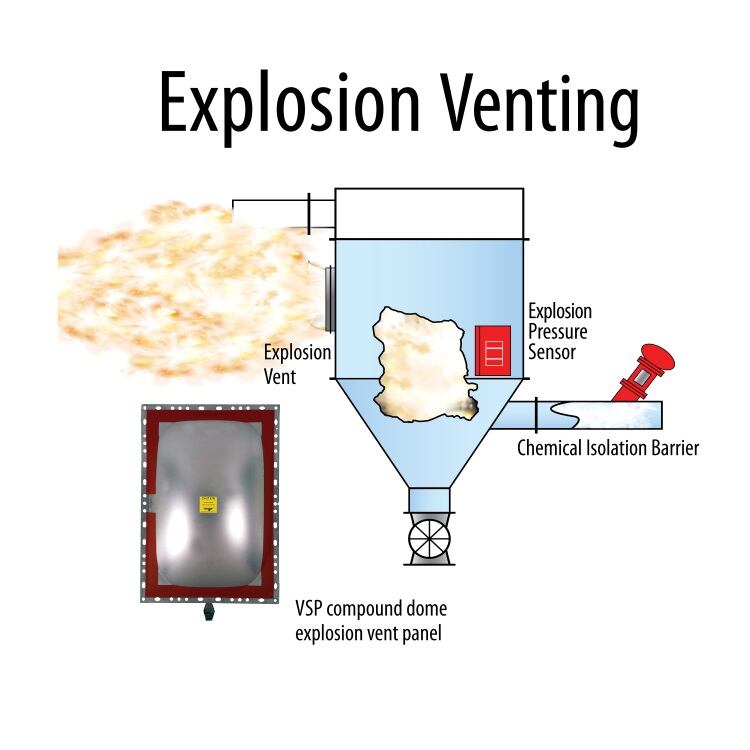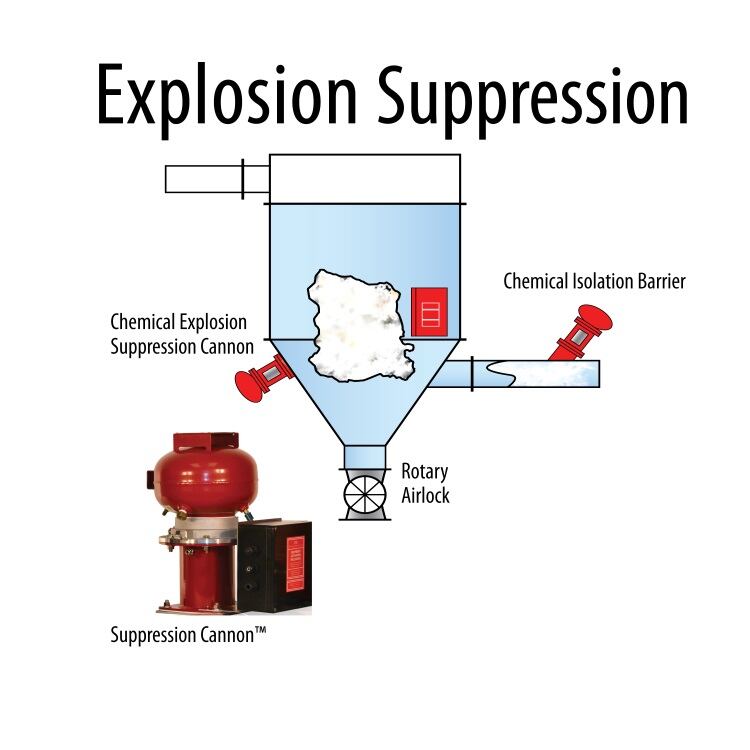1 January 2022 was the deadline for completion of a dust hazard analysis (DHA) for existing facilities, in accordance with Chapter 7 of the National Fire Protection Association’s (NFPA) Standard 61 (2020), for the Prevention of Fires and Dust Explosions in Agricultural and Food Processing Facilities.
NFPA 61 – and related NFPA Standards – details essential strategies to protect people, processes and property from the hazards presented by fires and dust explosions in facilities that handle, process and store bulk grains, including corn, wheat, oats, barley, sunflower seeds and soybeans, their byproducts, as well as other related combustible dusts.
All new processes and facilities that handle and/or generate combustible dusts are required to perform a DHA.
Appendix F of NFPA 61 (2020) provides a comprehensive checklist, which serves as a blueprint for generating a DHA. This checklist includes evaluating the dust explosion protection for process equipment that can often be at risk, such as bucket elevators, conveyors, grinders, silos and systems for spray drying and dust collection.
Careful consideration must be given to dust explosion mitigation and isolation in processing equipment to also ensure the protection of personnel and infrastructure. This will also limit the potential for preventable production and business interruptions.
However, the job is yet not finished.
The DHA team must also develop an action plan to identify hazards and prepare a prioritised action list with specific tasks, assigned parties, target timeframes and required resources. This will serve as a road map in reducing hazards, as well as a working document demonstrating reasonable effort towards managing risk.
Recommendations for addressing deficiencies in managing combustible dust hazards must be documented and addressed in a timely fashion acceptable to the authority having jurisdiction.
For many, this is an absolute quagmire of confusing regulations, so we’ve enlisted a safety expert to walk producers through a DHA, the NFPA 61 compliance and options to address the risk of combustible dust explosions.
“The DHA is only the starting point for bringing a facility and process into compliance with the relevant NFPA standards,” said Clive Nixon, sales manager at BS&B Pressure Safety management, a manufacturer of a broad range of dust explosion prevention and protection technologies.
“The next step is implementation. Before doing so, operators should consider some key questions.”
- Was the DHA completed by a person or team having credible experience in the facility and its process equipment with knowledge on the application of the relevant NFPA standards?
- Are there any areas of the DHA that are missing or incomplete?
- Have there been any relevant changes to the facility or process that merit an update to the DHA?
- Are all components of the DHA clear with specific action items or are clarifications needed?
- Do we know how to implement the action items arising from the DHA?
- What are our protection options to achieve compliance?
Nixon recommends reviewing or updating the DHA with a safety expert if anything is missing or unclear, as the potential liability of insufficient compliance and protection can be very costly if a combustible dust explosion was to happen.
“There are a range of solutions to provide cost-effective protection against the combustible dust hazard, but each facility’s choice will vary depending on their specific needs.
“The technology selection should not only consider factors such as the nature of the dust hazard and its characteristics, but also equipment location, strength, operating pressures, temperatures, and process interconnections.
“Owners and operators are best served by working with an expert supplier with access to a complete range of safety solutions for a particular application. They should be aware that a supplier having only one particular solution may be biased in their recommendations.”
According to Nixon, the primary options for explosion protection & prevention include explosion venting, explosion suppression and explosion isolation.
Explosion relief venting

Venting is the most widely adopted protection mechanism because it’s typically convenient and economical. While it’s perceived as a fit-and-forget solution, it does require regular inspection (per NFPA 68). It’s often the most practical solution for equipment located outside or near to an outside wall – where a clear path is needed and a dust explosion fireball will not endanger people enroute to a safe area.
During the early stages of a dust explosion, explosion relief vents open rapidly at a predetermined burst pressure. This allows the rapidly expanding combustion gases and dust/air mixture to escape, limiting the pressure generated within the equipment to calculated safe limits. Most agri dust materials develop a pressure in excess of 100 psi in a fraction of a second if the process enclosure was sufficiently strong.
The method of sizing vents and the strength of the equipment are important considerations, as is the path of the explosion relief flame ball and the accessibility of the vent panels for occasional inspection and maintenance. The vent area calculation basis is not the same for raw grain and processed grain, so the two will require different vent quantity and positions. These are covered in NFPA 61 and NPFA 68.
According to Nixon, some applications – such as when the boot of a bucket elevator or other equipment is inside a building or below grade – require a different approach, such as flamefree venting.
These vents are designed to diffuse the pressure wave and eliminate the flame that would normally be projected by a vented explosion. It’s a conventional vent mounted in front of a housing that incorporates a stainless-steel mesh, which extracts the heat of the deflagration while allowing the explosively expanding gases to be discharged safely.
The mesh is configured to partially absorb the pressure wave of the expanding gases and to capture dust and soot particles to a varying degree that determines the ‘vent efficiency’ – typically between 50% and 95%, which means that a flamefree vent area calculation is going to be larger than a conventional vent for the same application.
Explosion suppression

Explosion suppression systems – in contrast to venting – are are designed to suppress a deflagration in its initial stage before destructive pressure can be generated.
It’s designed to immediately respond to pressure or flame detector, rapidly discharging a flame quenching agent, such as sodium bicarbonate. This effectively halts the explosion in its infancy and results in a reduced explosion pressure that is safe for the protected equipment.
‘Think of explosion suppression as a fire extinguisher that triggers automatically but at about 1,000 times the speed,” said Nixon.
A further advantage is the speed of cleanup and refit, which allows for a quick return to production.
This method is typically applied to double leg bucket elevators used in grain handling. Protection consists of explosion detection and suppression of the elevator head and boot section, as well as explosion isolation of the leg casings, feed and discharge points and dust extraction points.
Explosion isolation
This is a vital component to any explosion protection strategy.
A dust explosion can result in secondary events in connected equipment, which can be more destructive than the initial event. As such, isolation is a critical component for all process interconnections such as inlet ducts, discharge ducts and dust extraction points.
Although explosion isolation is a component of explosion suppression systems, it’s not an intrinsic feature of explosion venting systems.
This means that when vents are chosen for protection, a means of chemical or mechanical isolation should also be considered. NFPA 69 details compliant solutions.
While it may be tempting for a processor to apply only partial protection to a process system, care must be taken to manage the risk both to and from connected equipment.
A piece of unprotected equipment can be the Achilles heel to a facility protection plan.
Don’t take shortcuts

“For grain and food processors, there are many critical decisions involved beyond the DHA in selecting dust explosion prevention, protection and mitigation equipment given the areas at risk, the methods of protection, relevant NFPA codes, other jurisdictional requirements, and the type of material processed,” said Nixon.
“However, careful attention to dust explosion mitigation and isolation in processing equipment can ensure the protection of both facility personnel and infrastructure.
“This will also limit the potential for preventable production and business interruptions.”


